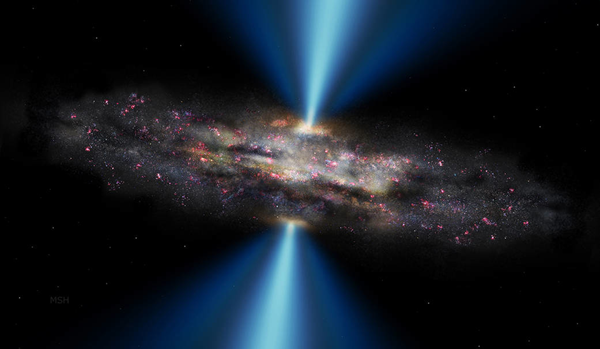Black holes are ready for their close-up, thanks to a new algorithm which could give astronomers a way to take the first image of a black hole by next spring.
Katie Bouman, an MIT graduate student in computer science, developed the algorithm, which essentially uses Earth as a giant radio wave dish. Bouman will present the research at the Computer Vision and Pattern Recognition conference in June.
The problem with capturing a picture of a black hole is that even the closest one, the supermassive black hole called Sagittarius A at the center of our Milky Way galaxy, is very, very far away. Any images taken before show the effects of the black hole, rather than the event horizon itself.
Radio waves are ideal signals for some reasons—they pass through solids, so they can reach Earth across such a vast distance—but they also have very long wavelengths. This means astronomers need a truly huge radio wave dish to capture enough waves to produce an image. To image something the size of the Milky Way black hole, Bouman explains, “You’d need a telescope the size of the Earth.”
That’s just what the Event Horizon Telescope project is trying to create, by collecting data from radio telescopes all over the world. The project currently includes six radio telescopes, but there are not enough radio telescopes in the world that can observe at the desired frequency (1.3mm), or even enough suitable sites in the world on which to build such telescopes. (They need to be on top of mountains and at sites that limit the interference of water vapor.) Bouman’s algorithm is designed to make up the difference.
To do this, her algorithm, called CHIRP (Continuous High-resolution Image Reconstruction using Patch priors), first combines the signals from three different telescopes. By using three, instead of two (which most others do), the delays to the radio waves caused by Earth’s atmosphere cancel each other out.
But even after that, “there’s an infinite number of images that will perfectly describe the data,” Bouman says. So the next step is to use the data to reconstruct an image that looks like an image. That may seem self-evident, but when images are broken up into tiny patches, Bouman explains, “oftentimes there’s a lot of repeating structure: flat patches, an edge.” She built a machine-learning algorithm that identified those repeating patches, called patch models, and used them to reconstruct images.
Amazingly, the algorithm worked when it was trained on any kind of image, astronomical or terrestrial.
“We can take images on your phone, we can take black hole simulation images, we can take images of cats,” says Bouman. “No matter if we trained on black hole images, celestial images, terrestrial images—the patch models that we learn are all similar enough that we ended up getting the same image back in the end.”
Multiple observatories will be used in the project, including the Sub Millimeter Array and James Clerk Maxwell Telescope in Hawaii; the Heinrich Hertz Submillimeter Telescope in Arizona; the Large Millimeter Telescope in Mexico; the Institut de Radioastronomie Millimétrique in Spain; the Atacama Large Millimeter / submillimeter Array and Atacama Pathfinder Experiment in Chile; the South Pole Telescope in Antarctica; and the NOrthern Extended Millimeter Array in France.
Bouman’s algorithm was better than previous ones at reconstructing an image from the measurements it would yield at different telescopes, and it was better at handling noise in the data. The real test will come in the spring of 2017, when telescopes will begin collecting the data that could stitch together into our first image of a black hole.










